

Examining the number line near 12 we see that $$\lfloor 12.5\rfloor = 12$$ .
Graph for (a)
Examining the number line near -6.7 we see that $$\lfloor -6.7\rfloor = -7$$ .
Graph for (b)
Since 50 is an integer, we know $$\lfloor 50\rfloor = 50$$ .
Using a calculator, we can determine that $$\pi$$ is approximately 3.14. Examining the number line near this point we see that $$\lfloor \pi\rfloor = 3$$ .
Graph for (a)
Using a calculator, we can determine that $$\frac$$ is approximately 1.21. Examining the number line near this point we see that $$\left\lfloor \frac\right\rfloor = 1$$ .
Graph for (b)
Using a calculator, we can determine that $$\sqrt 2$$ is approximately 1.41. Examining the number line near this point we see that $$\left\lfloor \sqrt 2\right\rfloor = 1$$ .
Graph for (c)
Sketch a graph of $$y = \lfloor 2x \rfloor$$ .
Show AnswerAs in the previous example, we can go about this by constructing a table, or interpreting the function in terms of transformations. This solution will do both.
$$ \begin <|c|c|c|>\hline x & 2x & \lfloor 2x \rfloor \\ \hline -0.75 & -1.5 & -2\\ -0.5 & -1 & -1\\ -0.25 & -0.5 & -1\\ 0 & 0 & 0\\ 0.25 & 0.5 & 0\\ 0.5 & 1 & 1\\ 0.75 & 1.5 & 1\\ 1 & 2 & 2\\ 1.25 & 2.5 & 2\\ \hline \end $$
In this case, we see that every time $$x$$ is a multiple of 0.5 the function jumps to the next higher integer.
We can interpret $$y = \lfloor 2x \rfloor$$ as a horizontal compression by a factor of 2. That is, each of the $$x$$-values from $$y = \lfloor x\rfloor$$ gets cut in half, but the $$y$$-values stay the same.
Show Answer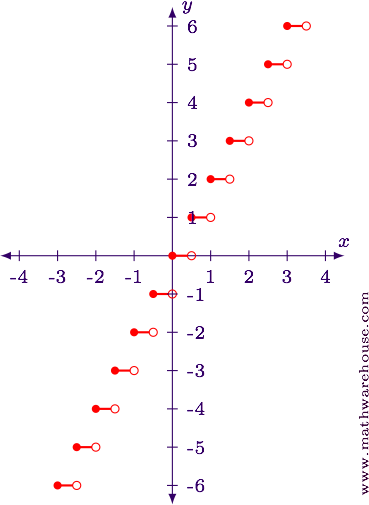
Sketch a graph of $$y = \lfloor 1.5x \rfloor$$ .
Show AnswerWe will examine this function using both a table, and then as a transformation of functions.
Step 1 Answer$$ \begin <|c|c|c|>\hline x & 1.5x & \lfloor 1.5x \rfloor \\ \hline -1 & -1.5 & -2\\ -2/3 & -1 & -1\\ -1/3 & -0.5 & -1\\ 0 & 0 & 0\\ 1/3 & 0.5 & 0\\ 2/3 & 1 & 1\\ 1 & 1.5 & 1\\ 4/3 & 2 & 2\\ 5/3 & 2.5 & 2\\ 2 & 3 & 3\\ \hline \end $$
The table shows that the function increases every multiple of 2/3.
Since the variable $$x$$ is being multiplied by 1.5, we know that the graph of $$y = \lfloor x\rfloor$$ is being compressed horizontally.
Show Answer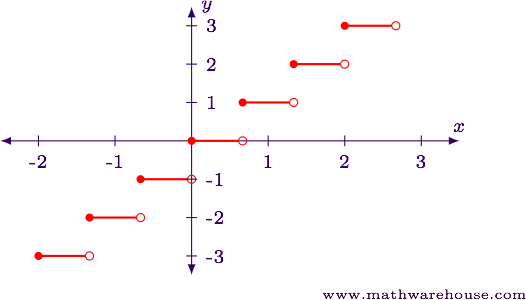
Sketch a graph of $$y = \lfloor -0.25x\rfloor$$ .
Show AnswerWe will examine this function using both a table, and then as a transformation of functions.
Step 1 Answer$$ \begin <|c|c|c|>\hline x & -0.25x & \lfloor -0.25x \rfloor \\ \hline -4 & 1 & 1\\ -3 & 0.75 & 0\\ -2 & 0.5 & 0\\ -1 & 0.25 & 0\\ 0 & 0 & 0\\ 1 & -0.25 & -1\\ 2 & -0.5 & -1\\ 3 & -0.75 & -1\\ 4 & -1 & -1\\ \hline \end $$
The table shows that the function increases every multiple of 4.
Since the variable $$x$$ is being multiplied by 0.25, we know the function is being horizontally stretched by a factor of 4. Since the coefficient is negative, the function is also being reflected about the $$y$$-axis.
Show Answer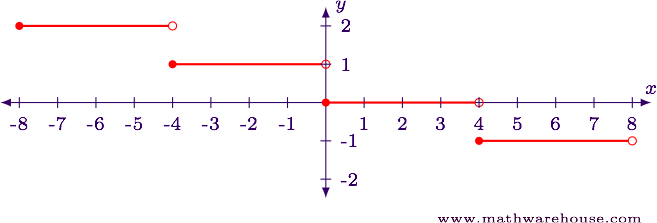
Sketch a graph of $$y = 2\lfloor x\rfloor$$ .
Show AnswerWe will examine this function using both a table, and then as a transformation of functions.
Step 1 Answer$$ \begin <|c|c|c|>\hline x & \lfloor x \rfloor & 2\lfloor x \rfloor\\ \hline -1.5 & -2 & -4\\ -1 & -1 & -2\\ -0.5 & -1 & -2\\ 0 & 0 & 0\\ 0.5 & 0 & 0\\ 1 & 1 & 2\\ 1.5 & 1 & 2\\ 2 & 2 & 4\\ \hline \end $$
The table shows that the function increases by 2 every time $$x$$ increases by 1.
The function has a vertical stretch by 2.
Show Answer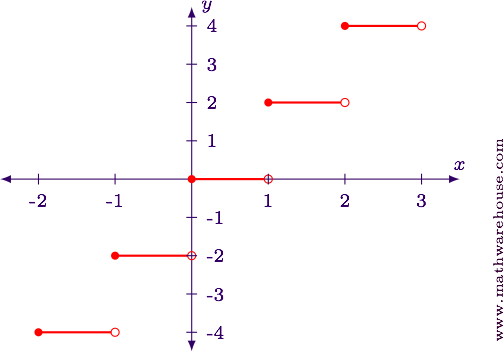
Sketch a graph of $$y = \lfloor x + 3\rfloor$$ .
Show AnswerWe will examine this function using both a table, and then as a transformation of functions.
Step 1 Answer$$ \begin <|c|c|c|>\hline x & x + 3 & \lfloor x + 3\rfloor \\ \hline -4 & -1 & -1\\ -3.5 & -0.5 & -1\\ -3 & 0 & 0\\ -2.5 & -0.5 & 0\\ -2 & 1 & 1\\ -1.5 & 1.5 & 1\\ -1 & 2 & 2\\ -0.5 & 2.5 & 2\\ 0 & 3 & 3\\ 0.5 & 3.5 & 3\\ 1 & 4 & 4\\ \hline \end $$
The table shows us that the function increases each time $$x$$ is an integer.
The function $$y = \lfloor x + 3\rfloor$$ is a shift to the left by 3 units of the function $$y = \lfloor x \rfloor$$ .
Show Answer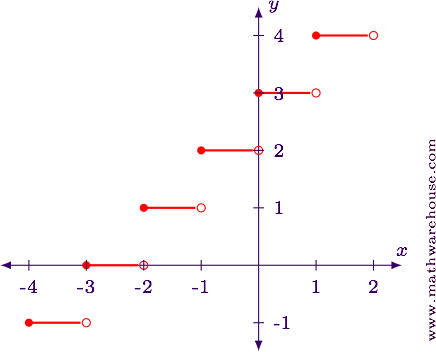
Sketch a graph of $$y = -0.75\lfloor 2 - x\rfloor$$ .
Show AnswerWe will examine this function using both a table, and then as a transformation of functions.
Step 1 Answer$$ \begin <|c|c|c|c|>\hline x & 2 - x & \lfloor 2 - x \rfloor & -0.75\lfloor 2 - x \rfloor\\ \hline -2.5 & 4.5 & 4 & 3\\ -2 & 4 & 4 & 3\\ -1.5 & 3.5 & 3 & 2.25\\ -1 & 3 & 3 & 2.25\\ -0.5 & 2.5 & 2 & 1.5\\ 0 & 2 & 2 & 1.5\\ 0.5 & 1.5 & 1 & 0.75\\ 1 & 1 & 1 & 0.75\\ 1.5 & 0.5 & 0 & 0\\ 2 & 0 & 0 & 0\\ 2.5 & -0.5 & -1 & -0.75\\ \hline \end $$
The table shows that the function changes value just after $$x$$ is an integer. Each time the function changes value it decreases by 0.75.
The function $$y = -0.75\lfloor 2 - x\rfloor$$ consists of four different transformations.